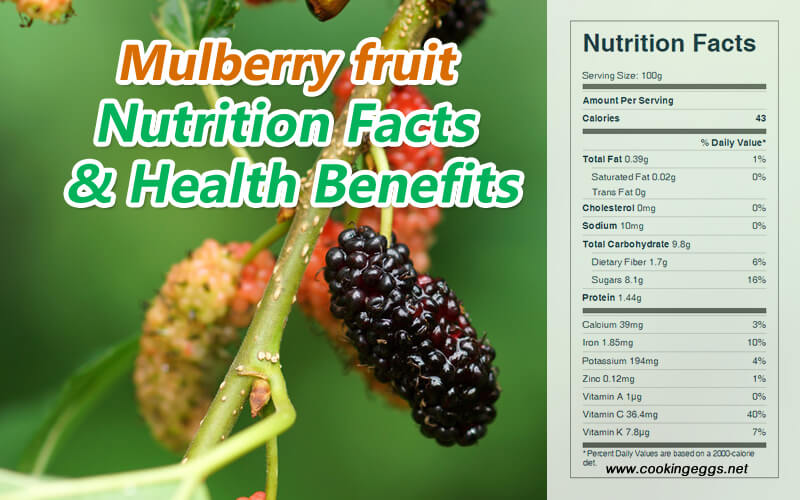Mulberry fruit Nutrition Facts and Health Benefits
Mulberries are widely distributed in the world and originated in Southeast Asia. There are three principal species, including the white mulberry, black mulberry, and red mulberry. They have juicy fruits with a nice color and a unique, slightly acidic flavor.
- The black mulberry is native to western Asia and has been grown in Europe and the Middle East since ancient times for its fruits. Black mulberries are large and juicy, with a balanced sweetness and tartness, resembling a blackberry. The black mulberry is no doubt the most flavorful, with its refreshing combination of sweetness and tartness.
- The red mulberry is native to America and is usually a deep red-purple. The red mulberry is not as tasty as its black cousin. Red mulberries are usually deep red, sweet, and juicy.
- The white mulberry is native to eastern and central China, where the tree has long been cultivated for its leaves, which are the essential food for silkworms. The white mulberry fruit is the least tasty of the three. Fruits are typically sweet, a little tart, with a bit of gumminess to them and a hint of vanilla.
Nutritional Value of Mulberry fruit
Raw mulberries are 88% water, 9.8% carbohydrates, 1.4% protein, and less than 1% fat. They are a source of vitamins C, E, and K. It also contains iron, calcium, manganese, and potassium.
In a 100-gram reference amount, raw mulberries supply 43 calories, 9.8 g carbohydrate, 1.44 g protein, 0.39 g fat, 36.4 mg vitamin C, 7.8 µg Vitamin K, 0.87 mg Vitamin E, 39 mg calcium, 1.85 mg iron, 18 mg magnesium, 38 mg phosphorus, 194 mg potassium, 10 mg sodium, and 18 mg manganese.

Raw Mulberries Nutrition Facts Label
Health Benefits of Mulberry fruit
Mulberries are sweet fruits, and they play an important role in the food industry due to their high levels of bioactive compounds. For this reason, mulberries can be considered a good source of nutrients and antioxidant compounds (especially anthocyanins and polyphenols), and they can also provide nutritionally useful amounts of minerals.
Mulberry fruits are currently consumed as both fresh and processed products (juices, fruit salads, and dried fruits) due to their nutritive value. The production and consumption of mulberry fruits is rapidly increasing, largely due to their aromatic taste, nutritional value, and biological activities. One of the most important bioactive constituents of mulberries are the anthocyanins. These pigments have dual value: first, they constitute an integral part of the sensory attributes since their levels and various forms pertain directly to the coloration of the final product; and second, they are thought to possess diverse biological properties and therefore are considered as secondary metabolites with potential nutritional value. Several researchers have studied the contents of phenolics (flavonoids and anthocyanins) and carotenoids in mulberry extracts.
Apart from being a food item, mulberry fruit has been used in folk medicine for thousands of years, especially in China, for treating sore throats, anemia, and tonsillitis. Modern research revealed that, due to the rich content of bioactive polyphenols, mulberry fruits were confirmed to possess a wide scope of bioactivities, such as free-radical scavenging, antidiabetic, neuroprotective, antifatigue, antiatherosclerosis, anti-thrombotic, immune-modulating, and others.
Mulberry fruit is a good source of iron (10% of the DV). Iron is essential for red blood cells, where most of the human body's iron is contained. Controlling iron levels in the body is a critically important part of many aspects of human health and disease.
Mulberries are rich in vitamin C(40% of the DV). It is used to prevent and treat scurvy. Vitamin C is an essential nutrient involved in the repair of tissue, the formation of collagen, and the enzymatic production of certain neurotransmitters. It also functions as an antioxidant.
Mulberry fruits have higher antioxidant activity and have higher polyphenol content than some other fruits. The mulberry extract effectively inhibited cellular reactive oxygen species production by 93%. Mulberry’s nonanthocyanin flavonoids not only reduced lipid peroxidation in vivo but also improved blood and liver antioxidant status measured by GSH-Px activity. Mulberries have an antioxidative ability 3.5 times stronger than Trolox, whereas pelargonidin, which was also found in mulberries, was reported to have an AOA equal to that of Trolox.
Hypolipidemic and anti-obesity effects of mulberries. It is known that elevated levels of triglycerides, body weight, free fatty acids, and low-density lipoprotein cholesterol are risk factors for obesity-related chronic diseases. Many studies have demonstrated the hypolipidemic properties of mulberry extracts. Mulberry fruit aqueous extract can reduce the levels of triglycerides, cholesterol, and low-density lipoprotein cholesterol in the serum and atherosclerosis in the aorta. Mulberry anthocyanin-rich extracts had a 10-fold greater effect than mulberry water extracts on atherosclerosis and obesity prevention via inhibiting the formation of foam cells.
Mulberry fruits have hypoglycemic effects. Mulberry anthocyanin not only prevented the progressive decline of insulin secretion through protecting β-cells but also enhanced hepatic/peripheral tissue glucose uptake and, therefore, lowered the glucose blood levels. The anti-α-glucosidase activity of mulberry fruits, which delays the postprandial rise in blood glucose, is safer than commercial antidiabetics such as acarbose and voglibose. The anti-α-glucosidase activity of mulberry fruits, which delays the postprandial rise in blood glucose, is safer than commercial antidiabetics such as acarbose and voglibose.